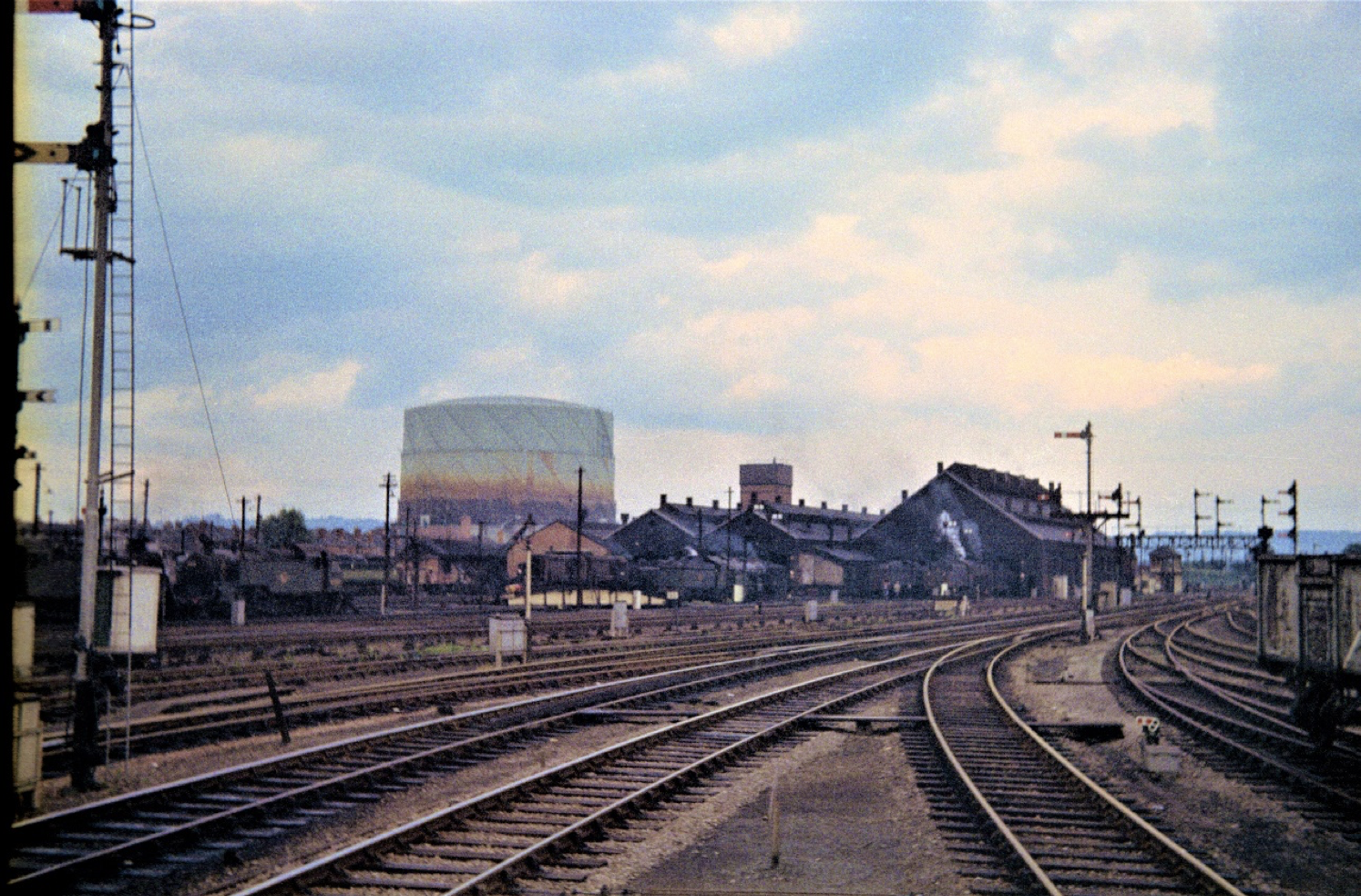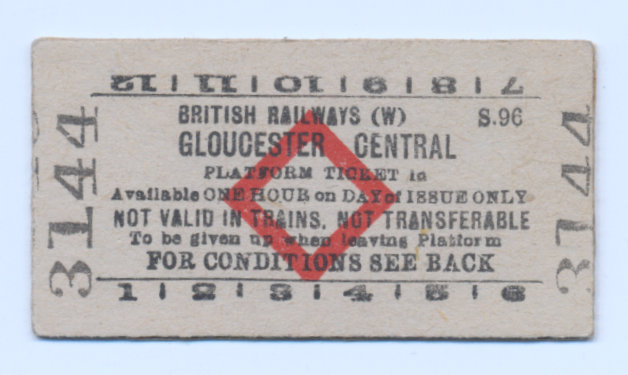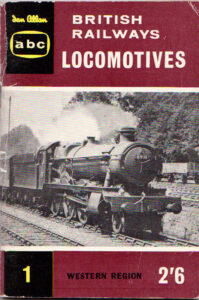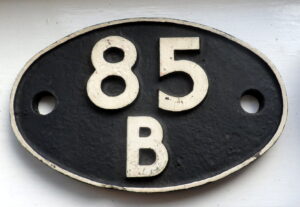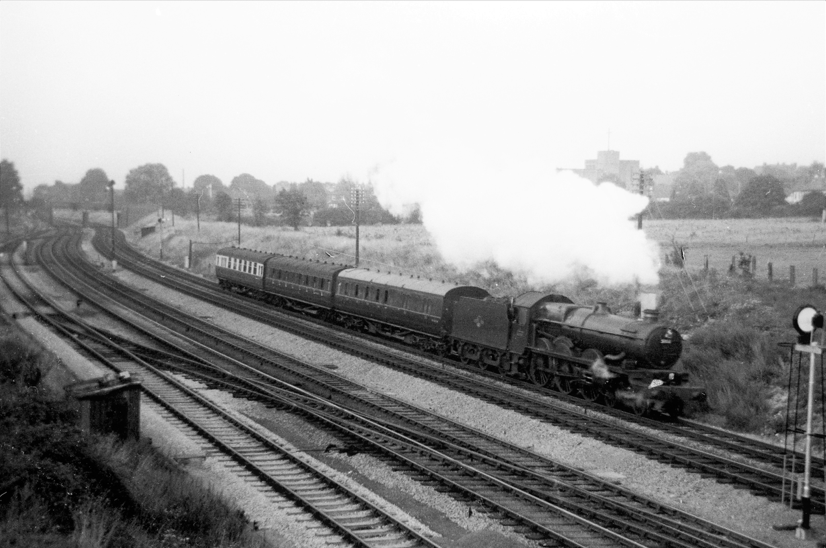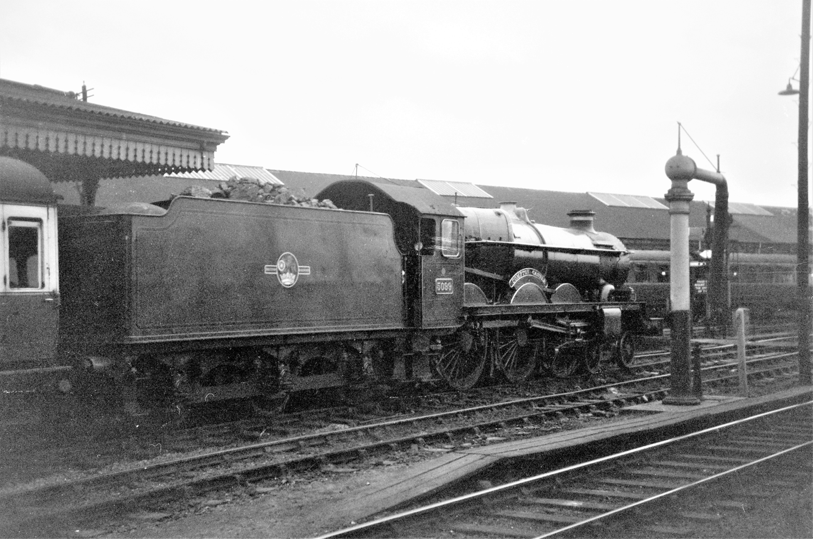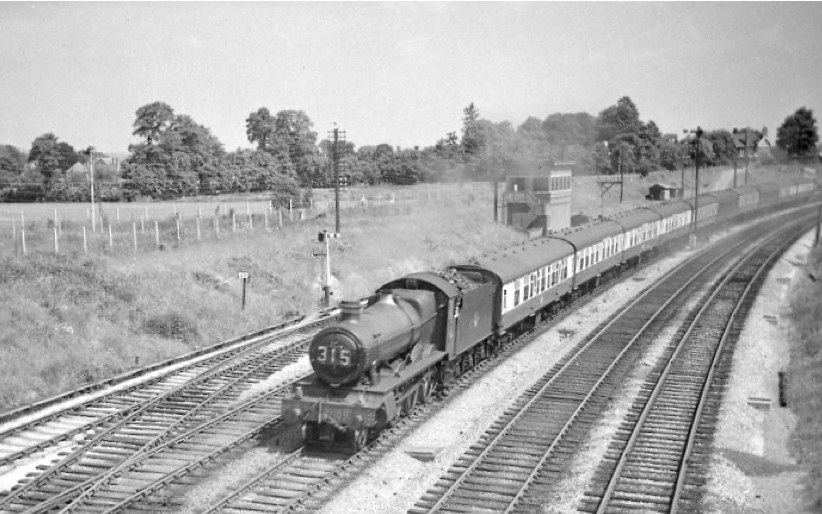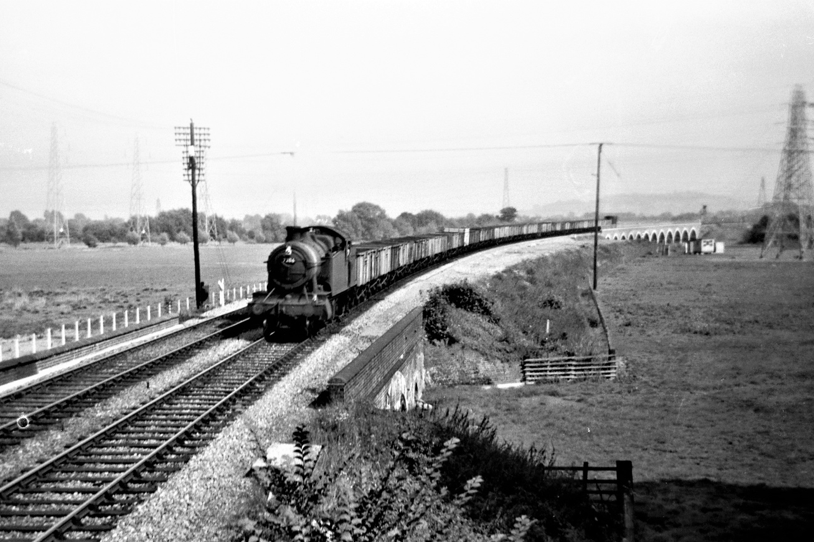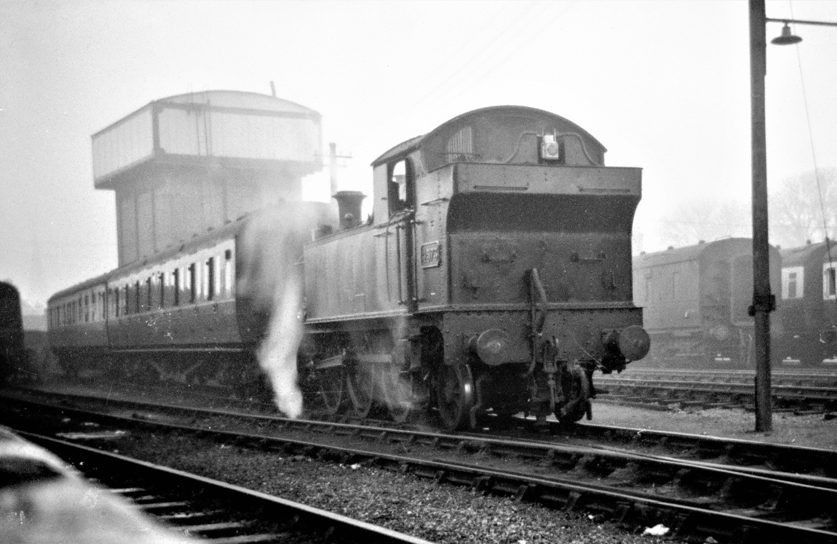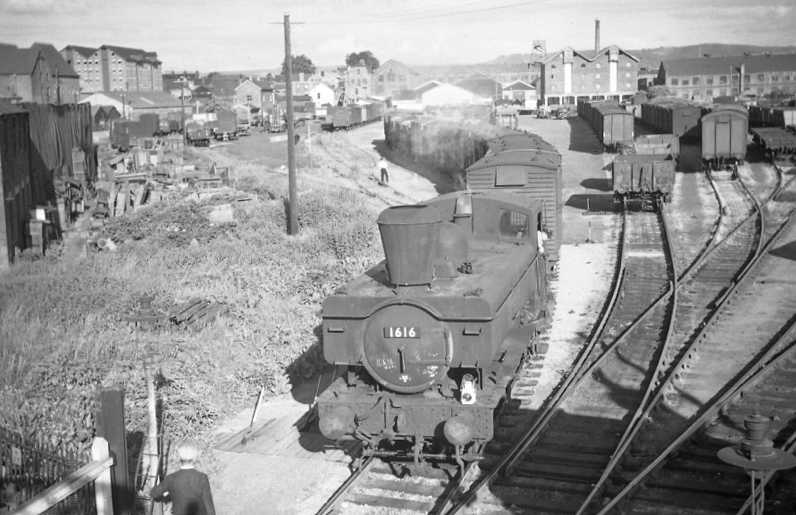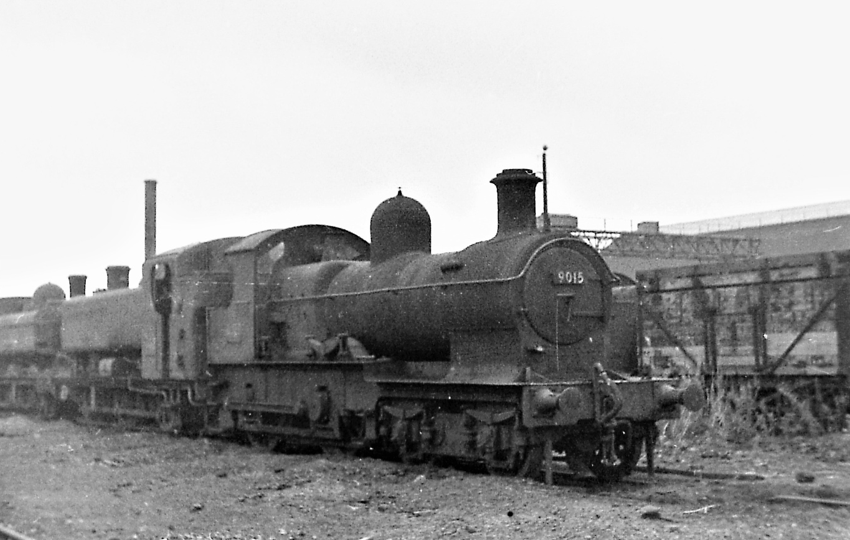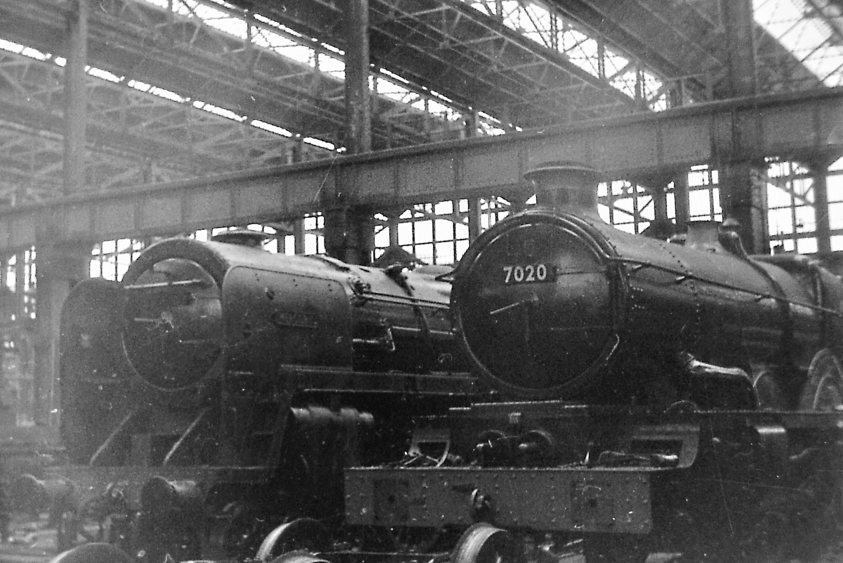Early Western Days
Two school trips
My earliest Western travel memory was taking part in a ‘School Journey’ from Finlay Road Junior School to Weymouth in 1954 by chartered train! A fleet of Say’s double deck buses (DOD registrations, as I remember) carried us to Eastgate station, where a train of four coaches hauled by ‘Hall’ 4-6-0 No. 4996 Eden Hall formed our excursion. We all went to Dorothy’s Café in Weymouth for tea. A year later (probably on 23 April) whilst still at Finlay Road, I surprised my form teacher by putting my name down for a school trip by train to Wembley to see a schoolboy football international, despite having little interest in the sport: I remember nothing of the match! According to TI, three Gloucester locos (Nos. 7006 Lydford Castle, 5907 Marble Hall, and 5951 Clyffe Hall) were recorded as taking specials to Wembley. One vivid memory is of seeing my first A3 Pacific, No. 60044 Melton passing through Wembley Hill on a GC express. This was a Leicester (38C) engine, but would shortly be transferred to New England, being replaced by No. 60111 Enterprise.
Gloucester Central activity
A Gloucester Central platform ticket
From the autumn of 1955 I walked to school every day past Tuffley Junction and could spot Western Region trains on the Swindon line. But if I wished to observe Western activity between South Wales and Birmingham it was necessary to visit Central station. The most practical place for observation was the north end of Eastgate’s island platform, from which all movement into Central station from the east could be observed. One of the more unusual sights one could witness from this vantage point was the recharging of Horton Road’s coaling stage. This would involve a 0-6-0PT under full regulator rapidly accelerating to get enough momentum to push three or four loaded coal wagons up the steeply graded ramp to the top of the coaling stage.
A Horton Road shedplate, and the cover of the Summer 1960 Western Region ABC (JT).
‘Castles’ were the largest GW locos allowed through Gloucester, as ‘Kings’ were banned owing to their axle-loading. The two most important Horton Road ‘Castle’ diagrams were the up ‘Cheltenham Spa Express’, leaving Gloucester at 8.19am, and the 12.7pm to Paddington. The locos returned from Paddington departing respectively at 2.15pm and 4.55pm. Regular locomotives observed on these turns during my spotting days are shown below:
| No. | Name | To 85B | From 85B |
| 4085 | Berkeley Castle | May 1958 | March 1960 |
| 5017 | The Gloucestershire Regiment 28th 61st | October 1951 | August 1962 (withdrawn) |
| 5018 | St Mawes Castle | October 1952 | March 1958 |
| 5042 | Winchester Castle | May 1939 | February 1959 |
| 5071 | Spitfire | May 1958 | September 1959 |
| December 1960 | February 1962 | ||
| 5094 | Tretower Castle | August 1956 | June 1958 |
| October 1958 | June 1960 | ||
| 7003 | Elmley Castle | June 1960 | April 1964 |
| 7006 | Lydford Castle | May 1951 | February 1958 |
| 7035 | Ogmore Castle | February 1960 | November 1962 |
No. 5017 The Gloucestershire Regiment 28th 61st was not known as the best performer. According to Ray Merrett, the father of a friend and an engine driver at Horton Road, No. 5042 Winchester Castle was the best of the bunch and preferred for the toughest duty of the day, the up ‘Cheltenham Spa Express’. This was especially so on Mondays, as Sir Brian Robertson, Chairman of the British Transport Commission, often caught this train at Kemble. Then the onus on the crew was to get to Paddington on time at 10.35am. This involved a non-stop mile-a-minute run from Kemble – 91 miles in 91 minutes.
Another interesting working was the 8.40am from Fishguard Harbour to Swindon, known to us as the ‘Enparts’, which left Gloucester after the 4.20pm to Paddington. ‘Enparts’ referred to the leading van that carried loco spares from Swindon works. The service also included ‘Cordon’ gas reservoir tanks that were used to transport the gas-cylinders employed for lighting in stations without a mains gas supply and cooking on the GW restaurant cars then in the consist of most expresses. In the opposite direction, a class C train composed of empty Express Dairies six-wheel milk tankers, worked down from London (at some time the 10.35am from Wood Lane to Neyland), and ran at passenger train speeds. This passed through Gloucester at about 4.30pm. Both workings were normally Gloucester ‘Castle’ duties.
On 24 August 1959 ‘Castle’ class 4-6-0 No. 5000 Launceston Castle, following a signal check at Tuffley Junction, heads home with the 7.00pm stopping train from Gloucester to Swindon. The three-coach train has an interesting selection of ex-GW vehicles, including a Collett non-corridor coach next to the engine.
Express locomotives from other sheds could be observed during the day. The Swindon line played host to an Old Oak Common (81A) ‘Castle’ which paid a daily visit to Gloucester on the 11.5am from Paddington, and 4.20pm return working. One of the regular performers was No. 7030 Cranbrook Castle, although ‘Modified Halls’ did turn up on occasion if a ‘Castle’ was unavailable: I particularly remember seeing on more than one occasion No. 6990 Witherslack Hall. One particular regret is losing a colour slide of ‘Castle’ No. 7037 Swindon, taken from Cole Avenue bridge working this train on 7 September 1961.
There were also additional stopping services between Gloucester and Swindon which could produce interesting express passenger locos, as two of these duties were used as running-in turns for locos that had been out-shopped from Swindon Works, and not normally seen in Gloucester. One loco arriving on the 7.58am passenger from Swindon returned on the 10.30am pick-up freight from New Yard to Swindon, whilst another turn brought the 9.28am passenger from Swindon into Gloucester, returning on the 2.40pm stopping service to Swindon.
Apart from the 81A turn, the most interesting ‘Castle’ working was that on the Birmingham – Swansea run. The six-coach express was worked by a Landore ‘Castle’, favourites being Nos. 4094 Dynevor Castle, 4099 Kilgerran Castle, 5013 Abergavenny Castle, and 7021 Haverfordwest Castle, all immaculately burnished with silver buffers and smokebox hinges. This working called at Gloucester at 12.25pm eastbound and 5.10pm westbound. [Other 87E ‘Castles’ seen during this time included Nos. 4074/6/93/7, 5004/16, 7009/12/6/28]. One other express turn between Birmingham Snow Hill and Cardiff, through Gloucester at 10.25am westbound and 6.35pm eastbound was rostered for a Tyseley ‘Modified Hall’. Regular performers included Nos. 7912 Little Linford Hall and 7918 Rhose Wood Hall. However, these steam-hauled services were replaced on 17 June 1957 when the first Swindon-built through-gangwayed Inter-City diesel multiple units with buffet cars in the W79083 series took over. They did not stay long on these duties and were replaced from 10 March 1958 by three-car Cross-country units also built at Swindon (in the W50700 series).
On a dull day in November 1959, ‘Castle’ class 4-6-0 Nos. 5099 Compton Castle has just arrived at Gloucester Central with the 1.45pm from Cardiff General to Cheltenham. The use of a ‘Castle’ on a train such as this was quite unusual. Note the Hawksworth tender which, judging by the amount of coal remaining, was fully coaled at Canton just before this duty.
One other train that used Central station was the express between Cardiff and Newcastle, which changed engines at Gloucester. This was the post-war equivalent of a daily train introduced in 1906 that once ran jointly by the GWR and GCR between Swansea and Newcastle via Banbury, using the Hatherley Curve to provide direct access from Gloucester to the Cheltenham – Kingham – Banbury line across the Cotswolds. By the mid-fifties, this service travelled the normal route via Birmingham and Derby and was distinguished by having until the late fifties a separate Bristol portion which was attached or detached at Gloucester Central. This gave the opportunity of occasionally seeing a Midland ‘2P’ 4-4-0 on an express working, albeit normally comprising only three carriages. There is a photograph of the ‘up’ working at Berkeley Road taken by P B Whitehouse in ‘Gloucestershire Steam Finale’ by Stephen Mourton (Runpast Publishing). The main Cardiff portion of the up train in the morning was a Cardiff Canton (86C) turn as far as Gloucester. A ‘Britannia’ was reported on this duty once, although I never saw one. The return working in the afternoon seemed to be worked west from Gloucester by anything Horton Road shed had available: really all that was required for the run on to Cardiff was a locomotive that could attain 60 mph on level track. I’d seen ‘4300’ class Moguls working this turn on occasion, but one afternoon in February 1961 I managed to record a visitor, No. 1018 County of Leicester (81E) waiting in the west end bay to take over the express at 2.45pm. It was withdrawn in September 1962.
I always found the ‘Counties’ rather elusive, and my attempts to photograph them were never that successful. Ex-works members of the class would regularly appear on the running-in turns from Swindon mentioned earlier. No. 1010 County of Caernarvon was photographed in June 1958 in green livery, but with the old BR crest [TI 52, 1984], and I have a poor snap of an immaculate No. 1021 County of Montgomeryshire at Gloucester Central in October 1959, newly fitted with a double chimney. One Sunday morning in November 1960 I managed to capture a pair of Swindon ones, Nos. 1004 County of Somerset (withdrawn September 1962) and 1012 County of Denbigh returning light through Tuffley Junction to their home depot. Otherwise, they could be seen occasionally on summer Saturday holiday trains between Wolverhampton and the south west. Wolverhampton Stafford Road (84A) had an allocation that had worked the ‘Cornishman’ in the early 1950s, but they had gone by 1959. By 1964 most ‘Counties’ had been consigned to the scrap heap, although the last of the class, No. 1011 County of Chester was retained for a while to work special trains, coming through Gloucester on an SLS special on 20 September that year.
The ‘Cornishman’ was an interesting service, calling at Eastgate, worked by a Stafford Road (84A) ‘Castle’ as far as Bristol, and a Laira (83D) one beyond. This ran from Wolverhampton Low Level via the GW Honeybourne line, opened as late as 1908 to provide the GW with its own route between Birmingham and Gloucester. A regular performer on the main train in 1957/8 was No. 4083 Abbotsbury Castle (84A), which worked the train continuously for several months from its ex-works state. Other regular 84A performers included Nos. 5010 Restormel Castle, 5015 Kingswear Castle, 5026 Criccieth Castle, 5032 Usk Castle and 7026 Tenby Castle. In summer it ran in two portions, the Dartmouth/Paignton portion normally being worked throughout by an 83A ‘Castle’. However, between March and May 1957, the Honeybourne line was closed for engineering work and, as a result, the ‘Cornishman’ was diverted via Worcester. A Worcester loco then worked the train through to Bristol, a regular performer being ‘Hall’ 4-6-0 No.7920 Coney Hall.
‘Hall’ Class 4-6-0 No. 4960 Pyle Hall heads the Kingswear portion of the ‘Cornishman’ south past Tuffley Junction on 13 June 1959. During the period of the summer timetable the train ran in two portions. Although an 83A duty, No. 4960 was shedded at Exeter at the time. The main train to Penzance would be hauled by an 84A ‘Castle’ as far as Bristol.
Four ‘Star’ 4-6-0s remained on the Western Region’s books in the 1950’s, and occasionally worked stopping trains to Swindon. These included the last, No. 4056 Princess Margaret (82A) which remained active on express work – on the West to north line for example – until withdrawn in October 1957, and No. 4062 Malmesbury Abbey (82C) – withdrawn in November 1956. The other two ‘Stars’, No. 4053 Princess Alexandra were withdrawn in July 1954 and No. 4061 Glastonbury Abbey (84A) in March 1957. I was also lucky to see the prototype ‘Castle’, No. 4000 North Star, at Central station on a Swindon stopping service before it was withdrawn in May 1957.
As far as I recall, Horton Road MPD had no ‘Grange’ 4-6-0s on its allocation, although No. 6865 Hopton Grange was reportedly reallocated to 85B for a short time in 1955. However, ‘Granges’ from Birmingham area sheds often worked through on fitted freights to the Bristol area and were also common on Summer Saturday holiday trains from Birmingham and Wolverhampton to the south west resorts from Weston to Penzance. Two ‘Manor’ 4-6-0s were also allocated to Horton Road MPD in 1954; Nos. 7808 Cookham Manor and 7810 Draycott Manor: they became regular performers on local trains during this time, also being recorded on MSWJ trains from Cheltenham to Andover in the early nineteen-fifties.
The largest ex-GW freight locos regularly seen through Gloucester were the ‘2800’ and ‘3800’ class 2-8-0s which had a near monopoly on freights carrying coal from South Wales to the Midlands and London area. Collett had also produced a tank version, the ‘7200’ class 2-8-2Ts, which were used interchangeably with the 2-8-0s. These locos were a rebuild of Churchward’s ‘4200’ class 2-8-0Ts which also worked up from South Wales. Occasionally one of the 2-8-2Ts could be found at the head of the 3.45am Aberdare to Swindon and Didcot freight, which came through Gloucester at around noon. This train was immediately recognisable because these engines were normally the only freight locos that were clean: their preparation was always a credit to their home shed, Aberdare (86J).
Collett’s 2-8-2Ts were regularly seen working through Gloucester on freight. Here No. 7206 coasts west from Gloucester across Mean Ham and the East channel of the River Severn on the approach to Over Junction with a long haul of empty coal wagons for Severn Tunnel Junction. The date is 27 August 1959.
One other class that could be seen very occasionally at Gloucester were the ‘ROD’ 2-8-0s: indeed, a couple including No. 3048, had been allocated to 85B in the early fifties. These were GC-designed Robinson O4s originally built for use by the Railway Operating Division of the Army during WWI but had been ‘westernised’ with GW-type safety valves. The last three of the class (Nos. 3011/5/24) were withdrawn from Carmarthen (87G) at the end of October 1958. Some tenders from ROD locomotives survived, and I remember seeing one attached to a Churchward 2-8-0.
Representatives of many classes of smaller engines also found their way to Gloucester. The ‘1400’ class 0-4-2Ts used on the Chalford auto-train are so well known that only passing mention is necessary here. Prairie tanks were also commonly used on passenger trains between Gloucester and Cheltenham, but I always thought the smaller Churchward versions more interesting. One could often be found on station pilot duties.
In the murky twilight of a November 1959 afternoon, Churchward 2-6-2T No. 4573 provides heat for coaches in the carriage sidings adjacent to bay platform 6 used by Chalford auto-trains.
The Collett ‘2200’ class 0-6-0s were often seen on local passenger trains to Hereford as well as fulfilling their normal duties on freight. Normal motive power for the Hereford trains were the ‘4300’ class Moguls or the large ‘Prairie’ 2-6-2Ts of the ‘4100’ class. Horton Road MPD also had several ‘5600’ class 0-6-2Ts, a class mainly found in South Wales.
Another interesting class were the lightweight Hawksworth 0-6-0PTs in the ‘1600’ series. One, No.1616, worked as Docks Pilot at Llanthony Yard on the west side of Gloucester Docks. The Yard was accessed from the Docks Branch via a level crossing over Hempsted Lane (with a footbridge for pedestrians), adjacent to the East Channel river crossing. The loco was fitted with a spark arrestor, which might have been useful for working in Monk Meadow where timber was brought in for local firms. However, the loco had for a time worked from Worcester (85A), where the Divisional Superintendent who was responsible for Horton Road shed was based. Worcester shed provided a loco for the Cleobury Mortimer and Ditton Priors Light Railway [ref: 7] which served an armaments depot built just before WWII, and required a locomotive fitted with a spark arrestor. In 1957 the branch was sold to the Admiralty so a loco with a spark arrestor was no longer required. I managed to photograph No.1616 on 10 June 1959 before it was withdrawn in October after a working life of only ten years, being replaced by Gloucester’s first 204hp diesel shunter, No. D2123.
‘1600’ Class 0-6-0PT No. 1616, fitted with spark arrestor shunts Llanthony Yard serving Gloucester Monk Meadow Dock on 10 June 1959. The Pillar and Lucy Warehouse can be seen in the background.
The Docks Branch connected Llanthony Yard to the South Wales main line at Over Junction. The tracks crossed Alney Island on a causeway which contained a group of holding sidings for transfer traffic. It also gave access to Castle Meads power station, on the west bank of the East Channel of the Severn. The power station was built in 1941 (Gloucester’s earlier municipal power station was situated between Ladybellegate Street and the prison) and produced electricity under the auspices of the CEGB until 1969. The chimney was demolished by explosives in 1978. Although placed to receive coal by barge, much came by rail, and a fireless 0-4-0 loco, No. 1 built by Andrew Barclay in 1942 (builders no. 2126), was employed to shunt wagons. The sidings on the causeway also served another purpose as during the late 1960s locomotives waiting scrapping would be stored there, and a small number were cut up by Hayes Metals at Monk Meadow in situ.
Several of Hawksworth’s ‘1600’ series 0-6-0PTs also worked in the Forest of Dean, being sub-shedded at Lydney, and at least one, No. 1631, was still working there in late 1963. I never saw all of them, as they seemed to spend most of their life away from Gloucester. Remarkably, the final members of the class, designed as replacements for the superannuated Dean equivalents were still being constructed at Swindon as late as 1955, a sure indication that the GWR’s engine building policy had continued unabated despite nationalisation in 1948.
Hawksworth’s ‘9400’ series of taper-boilered 0-6-0PTs were also being constructed by Hawthorn-Leslie as late as 1955, whilst the last batch (Nos. 3400-9) were in store at Barry until early 1959 before being allocated to Cardiff Cathays (88A). Many of these pannier tanks had short lives, being scrapped after less than ten years’ service, whilst the first members of the ‘1600’ class were being withdrawn by 1960.
The ‘Great Western’ revisited
In 1955 the Western Region announced the re-introduction of the ex-GWR green livery for mixed-traffic locos including ‘Halls’, ‘Manors’, ‘Granges’ as part of their ‘Westernisation’ policy. In April 1956 two Taunton (83B) ‘Moguls’, Nos. 6358 and 6372 were repainted into the new livery specifically to haul the royal train on the Barnstaple branch on 7 May. No. 4358 was similarly repainted at Caerphilly works. By 1957 passenger tank engines were also being painted in GW colours. Another major event in March 1957 was the restoration of No. 3440 City of Truro to running order in an old GWR livery, working ‘running-in’ turns from Swindon to Gloucester a couple of times. It also double-headed a railtour to Hereford with a ‘Dukedog’ in May 1957.
‘Westernisation’ also saw the creation of more named express trains, complemented by pictorially adorned headboards for their locomotives. In addition, the rolling stock for these trains was repainted into a chocolate and cream livery indistinguishable from the old livery used by the GWR prior to nationalisation. The standard livery adopted by BR in 1949 for carriages was crimson lake and cream. Not to be outdone, the BTC in 1956 changed the standard livery for other passenger vehicles to maroon which bore a remarkable resemblance to the previous LMS livery, and that of the Midland Railway before 1923!
A new BR crest for locos was also introduced in June 1956, replacing an earlier totem which depicted a lion astride a wheel (‘the cycling lion’). The revised heraldic crest was described as “a demi-lion rampant holding between its paws a silver locomotive wheel, issuant from an heraldic crown on which are arranged a rose (England), thistle (Scotland) and leek (Wales), and an oak leaf (Britain)” – but referred to by some cynics as the ’ferret and dartboard’. I first saw the new crest adorning the tender of a ‘Hall’ 4-6-0 working the 10.30am freight to Swindon, rostered for an ex-works loco, from a top floor classroom of the Crypt School.
Early trips to Swindon Works
Some of my earliest memories related to Swindon Works and the scrap yard. In Gloucester Sunday morning was a good time to see light engines making what was often their last trip in steam to Swindon for scrapping. One Sunday, probably in March 1956, before going home for lunch from Tuffley Junction, I remember seeing No. 2101 (6C), a ‘Dean’ 0-6-0PT without a full cab near the end of its long trip from Birkenhead Docks. The last of the class, No. 2069, was recorded passing through Cheltenham on its way to Swindon in spring 1959.
The works were open to spotters on Wednesday afternoons and Sundays. On Sundays we would travel up on the 9.10am from Gloucester arriving at Swindon at 10.20am: returning on the 3.17pm (1.20pm off Paddington). This also gave us the opportunity, before returning home, to see one of the ‘B1’ 4-6-0s that worked regularly into Swindon on the Sunday 9.20am from Sheffield Victoria, arriving at Swindon at 2.08pm. The train originally was a through working to Swansea but was later truncated at Swindon. The return working left Swindon at about 5.0pm.
Entrance to Swindon Works was half-way down London Street from which a pedestrian subway led under the main railway line to Bristol. Admittance was controlled by a rather austere tall thin man with a rather prominent Adams-apple protruding from his long neck and dressed in a gaberdine mac and trilby hat.
Regular sights in the fifties were the ‘low numbers’, especially Taff Vale and Rhymney Railway 0-6-2Ts, the most numerous of the tank engines of the various independent railways in South Wales absorbed into the GWR in 1923. Such locos often finished their days as works pilots at Swindon before they too joined the scrap line for cutting up. Cardiff East Dock had an allocation of Taff Vale and Rhymney Railway 0-6-2Ts in 1955, and on a visit to Swindon in April 1957 Jeff found five recently withdrawn ex-TV tanks awaiting their fate (Nos. 349/64/76/85/97). Although the last seven TV 0-6-2Ts were withdrawn from Abercynon (88E) in August 1957, No. 394 was still intact at the works on 8 Feb 1959, despite being withdrawn three years previously.
Other independent railways whose locomotives were absorbed into the GWR included the Barry Railway, Alexandra Docks (Newport), Swansea Harbour Trust (SHT), and the Burry Port and Gwendraeth Valley Railway (BPGV). One of the Alexandra Docks 0-6-2Ts, No. 1205, which I never saw, was recorded at Newport Works in early 1956. BPGV No. 2198 was reported dead on 85B on 11 March 1959, presumably en route to Swindon. Most of the SHT 0-4-0ST dock tanks and the GWR equivalents (Nos. 1101-6) at Danygraig (87C) were withdrawn in January 1960, a victim of replacement by ‘D2000’ class diesel shunters. However, at least I had seen them previously on a Gloucestershire LSC trip with Pete Sharpe to the Swansea area in February 1959 that also included a visit to Swansea East Dock (87D), where a few dock shunters survived until 1963.
Another class that met its fate around this time was the ‘Dean Goods’ 0-6-0, the last pair being shedded at Oswestry (89A). I never saw one in Gloucester but No. 2516, withdrawn in May 1956 was languishing at Swindon works on 9 October 1960 prior to preservation. The ‘9000’ series outside-framed ‘Dukedog’ 4-4-0s, appeared in Gloucester occasionally, although most of them worked on the Cambrian system. I remember seeing one (I believe it was No. 9017, since preserved) head out towards Swindon on a freight one Saturday morning from the end of Eastgate island platform closest to Horton Road shed. No. 9025 was also recorded at Cheltenham on 8 August 1957. Two, Nos. 9011 and 9023, were based at Swindon until withdrawn in July 1957. However, No. 9015 was still intact on my October 1960 visit. A selection of photographs will be found in Photo Gallery.
A further Swindon trip with my camera in early 1961 on 29 January showed the scrap yard full of stored locomotives, most of which would be cut up. The Weighbridge House appears in some of my photographs. Many GW classes were represented, but it was surprising to see several of relatively new Hawksworth-designed engines in the 1500, 1600 and 9400 classes awaiting their fate. Some of these locomotives had seen less than ten years’ service. In contrast, ‘Castles’ were still being out-shopped with double-chimneys, including No. 7020 Gloucester Castle. But, as if to emphasise the changes now taking place, the works also contained the final batch of ‘Warships’, D866-70 under construction. ‘B1s’ were still working into Swindon on the Sunday 9.20am from Sheffield Victoria and its return working at about 3.30pm: this working was a truncated version of what was once a through train to Swansea.
Jeff and Roger visited Swindon Works on many occasions, and more details of their observations are being prepared.
Withdrawn ‘Dukedog’ 4-4-0 No. 9015 awaits scrapping in the concentration yard at Swindon Works on 9 October 1960.
‘Britannia’ Pacific No. 70024 Vulcan and ‘Castle’ No. 7020 Gloucester Castle under overhaul in Swindon Works ‘A’ shop on 29 January 1961.
